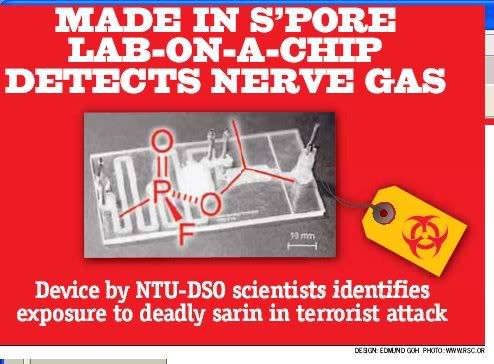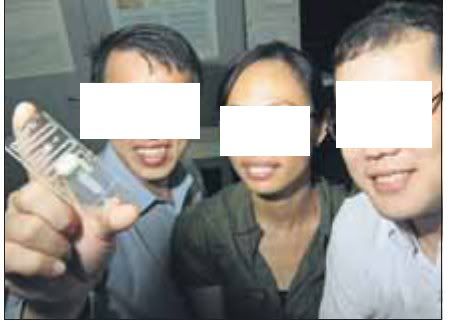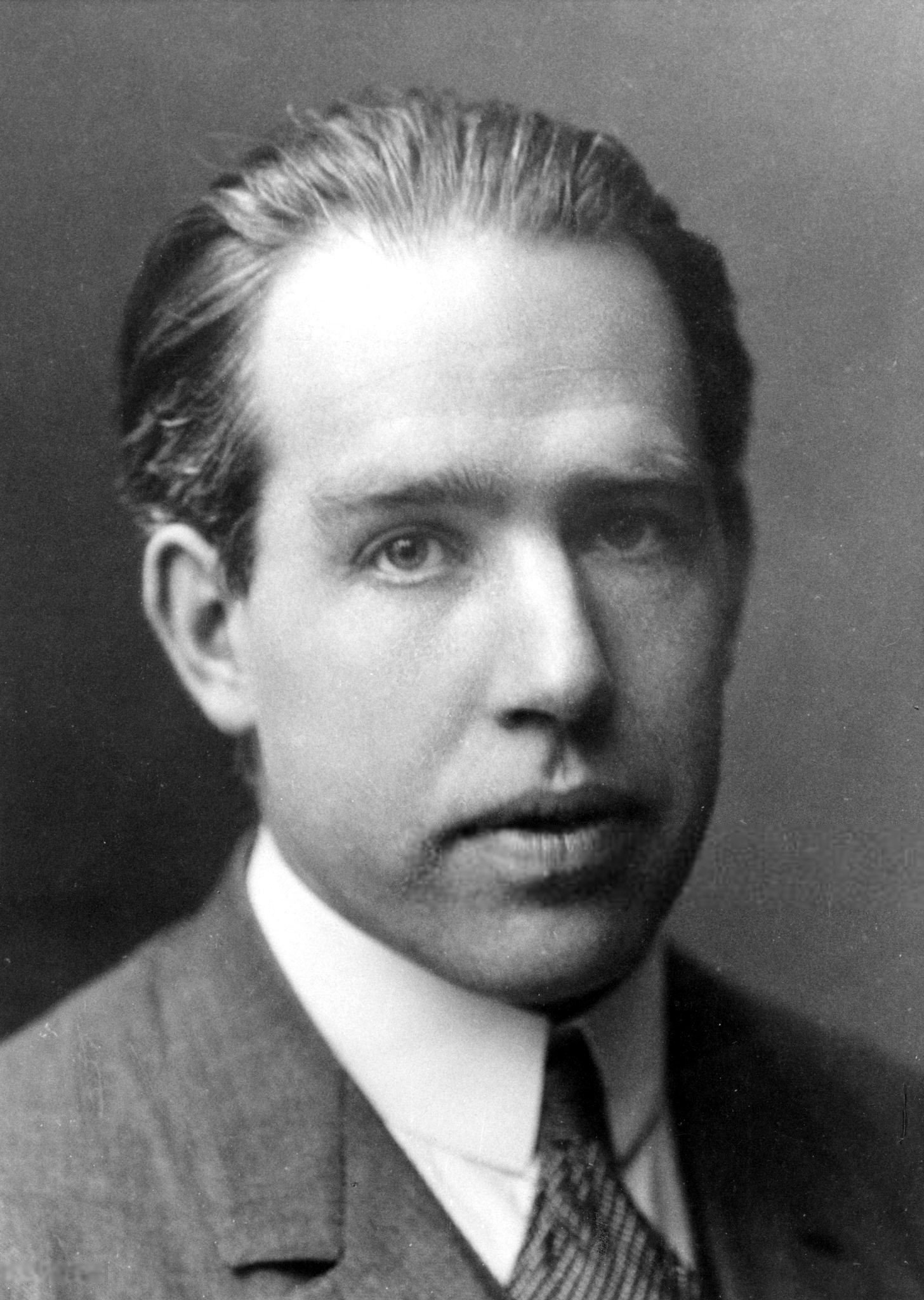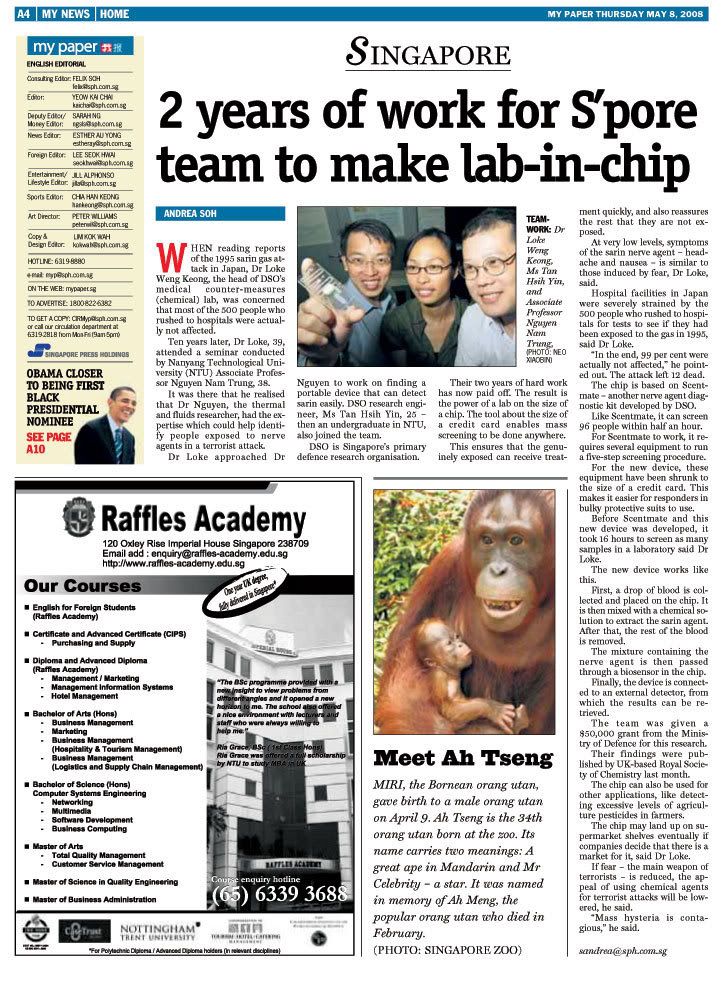Names & faces of DSO,DSTA etc shall be keep secret
-
ANDREA SOH
SCIENTISTS in Singapore
have produced a nerve
agent detector that fits on
to a chip the size of a credit
card.
This device will allow anti-biochemical
personnel responding
to a terrorist chemical
strike, such as the 1995 Tokyo
subway sarin attack, to quickly
identify those who are exposed
to the deadly gas.
It can detect sarin or other related
chemical warfare agents in
a small drop of blood.
The home-grown lab-in-achip
is the result of a two-year
research collaboration between
DSO National Laboratories and
Nanyang Technological University
(NTU).
The team recently published
details of their trials in the April
edition of the journal by the
prestigious UK-based Royal Society
of Chemistry.
The team comprises Dr Loke
Weng Keong, 39, the DSO head
of medical counter-measure
(chemical) lab, NTU Associate
professor Nguyen Nam Trung,
38, and DSO defence research
engineer Tan Hsih Yin, 25.
Commenting on the Singaporean
achievement, Professor Jonas
Berquist, who studies
chip-based blood analysis at
Uppsala University in Sweden,
said he was impressed with the
number of steps integrated into
the device.
“It’s a problem not many people
have solved yet,” he noted.
The device can screen 96 people
within half an hour and, being
easily mass-produced, many
more people can be checked at
the same time.
This would shave off crucial
minutes, which means the difference
between life and death for
people exposed to nerve agents.
Only a drop of blood is needed
to be put in the chip, which
can reveal results through an external
detector.
[email protected]
SEE REPORT IN HOME PAGE A4contd of quote:''2 years of work for S’pore
team to make lab-in-chipWHEN reading reports
of the 1995 sarin gas attack
in Japan, Dr Loke
Weng Keong, the head of DSO’s
medical counter-measures
(chemical) lab, was concerned
that most of the 500 people who
rushed to hospitals were actually
not affected.
Ten years later, Dr Loke, 39,
attended a seminar conducted
by Nanyang Technological University
(NTU) Associate Professor
Nguyen Nam Trung, 38.
It was there that he realised
that Dr Nguyen, the thermal
and fluids researcher, had the expertise
which could help identify
people exposed to nerve
agents in a terrorist attack.
Dr Loke approached Dr
Nguyen to work on finding a
portable device that can detect
sarin easily. DSO research engineer,
Ms Tan Hsih Yin, 25 –
then an undergraduate in NTU,
also joined the team.
DSO is Singapore’s primary
defence research organisation.
Their two years of hard work
has now paid off. The result is
the power of a lab on the size of
a chip. The tool about the size of
a credit card enables mass
screening to be done anywhere.
This ensures that the genuinely
exposed can receive treatment
quickly, and also reassures
the rest that they are not exposed.
At very low levels, symptoms
of the sarin nerve agent – headache
and nausea – is similar to
those induced by fear, Dr Loke,
said.
Hospital facilities in Japan
were severely strained by the
500 people who rushed to hospitals
for tests to see if they had
been exposed to the gas in 1995,
said Dr Loke.
“In the end, 99 per cent were
actually not affected,” he pointed
out. The attack left 12 dead.
The chip is based on Scentmate
– another nerve agent diagnostic
kit developed by DSO.
Like Scentmate, it can screen
96 people within half an hour.
For Scentmate to work, it requires
several equipment to run
a five-step screening procedure.
For the new device, these
equipment have been shrunk to
the size of a credit card. This
makes it easier for responders in
bulky protective suits to use.
Before Scentmate and this
new device was developed, it
took 16 hours to screen as many
samples in a laboratory said Dr
Loke.
The new device works like
this.
First, a drop of blood is collected
and placed on the chip. It
is then mixed with a chemical solution
to extract the sarin agent.
After that, the rest of the blood
is removed.
The mixture containing the
nerve agent is then passed
through a biosensor in the chip.
Finally, the device is connected
to an external detector, from
which the results can be retrieved.
The team was given a
$50,000 grant from the Ministry
of Defence for this research.
Their findings were published
by UK-based Royal Society
of Chemistry last month.
The chip can also be used for
other applications, like detecting
excessive levels of agriculture
pesticides in farmers.
The chip may land up on supermarket
shelves eventually if
companies decide that there is a
market for it, said Dr Loke.
If fear – the main weapon of
terrorists – is reduced, the appeal
of using chemical agents
for terrorist attacks will be lowered,
he said.
“Mass hysteria is contagious,”
he said.
[email protected]''end of quote..http://myepaper.mypaper.sg/ebook/web_php/fvbrowserjs.php?urljs=http://myepaper.mypaper.sg/ecreator/sphopf/ep080508cnd_opf_files/ep080508cnd.js&ver=Gen
1.SG will not compete with other giants in mega projects.
But she will spend efforts on niche and important areas
which will not appear very grand in medias photos,like missiles
,space adveutures etc
Do u think SG cant send a spaceman in a Russia space craft,like
MY did?
2.This small kit can save a lot of lifes.
3.Will DSO ,DSTA etc NOT to make the faces of staff appearing
in medias.This may endanger their lives or their family!!!

words in the image above ''10 mm''

Is there any Security Officer overseeing the safety of the staff and their family.
THis is damn stupid and negligent to allow their identity known,
including the names ,faces,etc
-
*smacks forehead*
Its not like they revealed our big names behind stuff like MetalStorm or something...
-
is this a weapon of mass destruction? is this technology so sophisticated that others must kidnap them in order to have it? cant they just buy one and afterwhich produce their own like sg did with the 6 new stealth ships?
-
oh ya and if what you said is true, wont you be making it worse by posting it on the net by making it more accessible?
-
Hmmm...

J Robert Oppenheimer

Niels BohrAnd last but not least...

Guess who?
These were all scientific titans and very public figures of their days... they were either nobel prize winners themselves, or who had produced research and made discoveries that were nobel prize winning material... And they all worked on the Manhatten Project.
Its a bit silly to suggest that scientists ought to be locked away like hermits and never see the light of day... They just happen to work in a military-linked lab, but their first and foremost pre-occupation is always their research and their scientific work, which is improved through sharing with fellow scientists at international conferences and scientific journals
just as our scientists read such papers and get useful ideas and directions for their research, it is only reasonable that they give back to these journals and get recognised for their good work through publications.
They do have to seek permission before submitting research for publication and it is considered an achievement in academia to have an article published in a well-known journal.
-
Originally posted by CX:
Hmmm...

J Robert Oppenheimer

Niels BohrAnd last but not least...

Guess who?
These were all scientific titans and very public figures of their days... they were either nobel prize winners themselves, or who had produced research and made discoveries that were nobel prize winning material... And they all worked on the Manhatten Project.
Its a bit silly to suggest that scientists ought to be locked away like hermits and never see the light of day... They just happen to work in a military-linked lab, but their first and foremost pre-occupation is always their research and their scientific work, which is improved through sharing with fellow scientists at international conferences and scientific journals
just as our scientists read such papers and get useful ideas and directions for their research, it is only reasonable that they give back to these journals and get recognised for their good work through publications.
They do have to seek permission before submitting research for publication and it is considered an achievement in academia to have an article published in a well-known journal.
-
dont worry la the picture of AH Tseng will distract the enemy.....they are suppost to be stupid right?

